Global Asymmetric Changes in Land Evapotranspiration Components During Drought: Patterns and Variability
Abstract
1. Introduction
2. Materials and Methods
2.1. Gridded Precipitation Dataset
2.2. GLEAM and ERA5-Land Datasets
2.3. Drought Identification Using the SPI
2.4. Probability of Drought-Driven Increase in ET
3. Results Analysis
3.1. Difference of ET Between Drought and Non-Drought Periods
3.2. Effect of Different Intensity of Drought on ET Components
3.3. The Global Distribution of the ET+ Phenomenon
3.4. Temporal Variation of ET Components During Drought Events
4. Discussion
5. Conclusions
- (1)
- The ET+ phenomenon is commonly observed during droughts, with a global average P(ET+) of approximately 0.5. In high-latitude regions, the increase in snow sublimation (Es) is a key contributor to ET+. In humid regions, the increase in transpiration (Et) plays a significant role in the overall increase in ET during droughts. Snow sublimation (Es) also increases in most high-latitude areas during meteorological droughts. While mild droughts may cause a reduction in ET, this reduction can be partially offset by increases in Eb and Es.
- (2)
- Event-based analysis indicates that the changes in ET during droughts primarily follow unimodal or bimodal patterns. The unimodal pattern is marked by a gradual decrease in ET during the early stages of drought, followed by a recovery in later stages. In contrast, the bimodal pattern involves sharp fluctuations in ET.
- (3)
- Our findings emphasize the importance of addressing the responses of individual ET components to drought separately, highlighting the need for region-specific strategies to mitigate drought stress.
Author Contributions
Funding
Data Availability Statement
Acknowledgments
Conflicts of Interest
References
- Williams, A.P.; Allen, C.D.; Macalady, A.K.; Griffin, D.; Woodhouse, C.A.; Meko, D.M.; Swetnam, T.W.; Rauscher, S.A.; Seager, R.; Grissino-Mayer, H.D.; et al. Temperature as a potent driver of regional forest drought stress and tree mortality. Nat. Clim. Change 2013, 3, 292–297. [Google Scholar] [CrossRef]
- Mohammed, R.; Scholz, M. Impact of Evapotranspiration Formulations at Various Elevations on the Reconnaissance Drought Index. Water Resour. Manag. 2017, 31, 531–548. [Google Scholar] [CrossRef]
- Oyounalsoud, M.S.; Yilmaz, A.G.; Abdallah, M.; Abdeljaber, A. Drought prediction using artificial intelligence models based on climate data and soil moisture. Sci. Rep. 2024, 14, 19700. [Google Scholar] [CrossRef]
- Bhaga, T.D.; Dube, T.; Shekede, M.D.; Shoko, C. Impacts of Climate Variability and Drought on Surface Water Resources in Sub-Saharan Africa Using Remote Sensing: A Review. Remote Sens. 2020, 12, 4184. [Google Scholar] [CrossRef]
- Singer, M.B.; Asfaw, D.T.; Rosolem, R.; Cuthbert, M.O.; Miralles, D.G.; MacLeod, D.; Quichimbo, E.A.; Michaelides, K. Hourly potential evapotranspiration at 0.1° resolution for the global land surface from 1981-present. Sci. Data 2021, 8, 224. [Google Scholar] [CrossRef] [PubMed]
- Bidabadi, M.; Babazadeh, H.; Shiri, J.; Saremi, A. Estimation reference crop evapotranspiration (ET0) using artificial intelligence model in an arid climate with external data. Appl. Water Sci. 2024, 14, 3. [Google Scholar] [CrossRef]
- Wang, R.; Li, L.; Gentine, P.; Zhang, Y.; Chen, J.; Chen, X.; Chen, L.; Ning, L.; Yuan, L.; Lü, G. Recent increase in the observation-derived land evapotranspiration due to global warming. Environ. Res. Lett. 2022, 17, 024020. [Google Scholar] [CrossRef]
- Wang, R.; Li, L.; Chen, L.; Ning, L.; Yuan, L.; Lü, G. Respective contributions of precipitation and potential evapotranspiration to long-term changes in global drought duration and intensity. Int. J. Climatol. 2022, 42, 10126–10137. [Google Scholar] [CrossRef]
- Zhao, M.; Geruo, A.; Liu, Y.; Konings, A.G. Evapotranspiration frequently increases during droughts. Nat. Clim. Change 2022, 12, 1024–1030. [Google Scholar] [CrossRef]
- Orth, R.; Seneviratne, S.I. Analysis of soil moisture memory from observations in Europe. J. Geophys. Res. Atmos. 2012, 117, D15115. [Google Scholar] [CrossRef]
- Teuling, A.J.; van Loon, A.F.; Seneviratne, S.I.; Lehner, I.; Aubinet, M.; Heinesch, B.; Bernhofer, C.; Grünwald, T.; Prasse, H.; Spank, U. Evapotranspiration amplifies European summer drought. Geophys. Res. Lett. 2013, 40, 2071–2075. [Google Scholar] [CrossRef]
- Miralles, D.G.; Teuling, A.J.; van Heerwaarden, C.C.; Vilà-Guerau de Arellano, J. Mega-heatwave temperatures due to combined soil desiccation and atmospheric heat accumulation. Nat. Geosci. 2012, 5, 739–743. [Google Scholar] [CrossRef]
- Novick, K.A.; Ficklin, D.L.; Stoy, P.C.; Williams, C.A.; Bohrer, G.; Oishi, A.C.; Papuga, S.A.; Blanken, P.D.; Noormets, A.; Sulman, B.N.; et al. The increasing importance of atmospheric demand for ecosystem water and carbon fluxes. Nat. Clim. Change 2016, 6, 1023–1027. [Google Scholar] [CrossRef]
- Frank, D.C.; Poulter, B.; Saurer, M.; Esper, J.; Huntingford, C.; Helle, G.; Treydte, K.; Zimmermann, N.E.; Schleser, G.H.; Ahlström, A.; et al. Water-use efficiency and transpiration across European forests during the Anthropocene. Nat. Clim. Change 2015, 5, 579–583. [Google Scholar] [CrossRef]
- Wang, R.; Lü, G.; Ning, L.; Yuan, L.; Li, L. Likelihood of compound dry and hot extremes increased with stronger dependence during warm seasons. Atmos. Res. 2021, 260, 105692. [Google Scholar] [CrossRef]
- Seneviratne, S.I.; Corti, T.; Davin, E.L.; Hirschi, M.; Jaeger, E.B.; Lehner, I.; Orlowsky, B.; Teuling, A.J. Investigating soil moisture–climate interactions in a changing climate: A review. Earth-Sci. Rev. 2010, 99, 125–161. [Google Scholar] [CrossRef]
- Miralles, D.G.; van den Berg, M.J.; Teuling, A.J.; de Jeu, R.A.M. Soil moisture-temperature coupling: A multiscale observational analysis. Geophys. Res. Lett. 2012, 39, L21707. [Google Scholar] [CrossRef]
- Jiang, Y.; Yang, M.; Liu, W.; Mohammadi, K.; Wang, G. Eco-hydrological responses to recent droughts in tropical South America. Environ. Res. Lett. 2022, 17, 114034. [Google Scholar] [CrossRef]
- Zhang, Y.; Liu, X.; Wang, K.; Bai, P. Response of evapotranspiration to the 2022 unprecedented extreme drought in the Yangtze River Basin. Int. J. Climatol. 2024, 44, 2779–2791. [Google Scholar] [CrossRef]
- Harris, I.; Osborn, T.J.; Jones, P.; Lister, D. Version 4 of the CRU TS monthly high-resolution gridded multivariate climate dataset. Sci. Data 2020, 7, 109. [Google Scholar] [CrossRef]
- Miralles, D.G.; De Jeu, R.A.M.; Gash, J.H.; Holmes, T.R.H.; Dolman, A.J. Magnitude and variability of land evaporation and its components at the global scale. Hydrol. Earth Syst. Sci. Discuss. 2011, 15, 967–981. [Google Scholar] [CrossRef]
- Martens, B.; Miralles, D.G.; Lievens, H.; van der Schalie, R.; de Jeu, R.A.M.; Fernández-Prieto, D.; Beck, H.E.; Dorigo, W.A.; Verhoest, N.E.C. GLEAM v3: Satellite-based land evaporation and root-zone soil moisture. Geosci. Model Dev. 2017, 10, 1903–1925. [Google Scholar] [CrossRef]
- Miralles, D.G.; Holmes, T.R.H.; De Jeu, R.A.M.; Gash, J.H.; Meesters, A.G.C.A.; Dolman, A.J. Global land-surface evaporation estimated from satellite-based observations. Hydrol. Earth Syst. Sci. 2011, 15, 453–469. [Google Scholar] [CrossRef]
- Priestley, C.H.B.; Taylor, R.J. On the assessment of surface heat flux and evaporation using large-scale parameters. Mon. Weather. Rev. 1972, 100, 81–92. [Google Scholar] [CrossRef]
- Muñoz Sabater, J. ERA5-Land Monthly Averaged Data from 1950 to Present. Copernicus Climate Change Service (C3S) Climate Data Store (CDS). 2019. Available online: https://cds.climate.copernicus.eu/datasets/reanalysis-era5-land-monthly-means?tab=overview (accessed on 4 August 2025).
- Panwar, A.; Kleidon, A. Evaluating the response of diurnal variations in surface and air temperature to evaporative conditions across vegetation types in FLUXNET and ERA5. J. Clim. 2022, 35, 6301–6328. [Google Scholar] [CrossRef]
- McKee, T.B.; Doesken, N.J.; Kleist, J. The relationship of drought frequency and duration to time scales. In Proceedings of the 8th Conference on Applied Climatology, Anaheim, CA, USA, 17–22 January 1993; Volume 17, pp. 179–183. [Google Scholar]
- Kourtis, I.M.; Vangelis, H.; Tigkas, D.; Mamara, A.; Nalbantis, I.; Tsakiris, G.; Tsihrintzis, V.A. Drought assessment in Greece using SPI and ERA5 climate reanalysis data. Sustainability 2023, 15, 15999. [Google Scholar] [CrossRef]
- Hoerling, M.; Eischeid, J.; Kumar, A.; Leung, R.; Mariotti, A.; Mo, K.; Schubert, S.; Seager, R. Causes and predictability of the 2012 Great Plains drought. Bull. Am. Meteorol. Soc. 2014, 95, 269–282. [Google Scholar] [CrossRef]
- Ummenhofer, C.C.; England, M.H.; McIntosh, P.C.; Meyers, G.A.; Pook, M.J.; Risbey, J.S.; Gupta, A.S.; Taschetto, A.S. What causes southeast Australia’s worst droughts? Geophys. Res. Lett. 2009, 36, L04706. [Google Scholar] [CrossRef]
- Santos, C.A.; Brasil Neto, R.M.; Nascimento, T.V.; Silva, R.M.; Mishra, M.; Frade, T.G. Geospatial drought severity analysis based on PERSIANN-CDR-estimated rainfall data for Odisha state in India (1983–2018). Sci. Total Environ. 2020, 750, 141258. [Google Scholar] [CrossRef]
- Odoulami, R.C.; Wolski, P.; New, M.G. Attributing the driving mechanisms of the 2015–2017 drought in the Western Cape (South Africa) using self-organising maps. Environ. Res. Lett. 2023, 18, 074043. [Google Scholar] [CrossRef]
- Yang, Y.; Roderick, M.L.; Guo, H.; Miralles, D.G.; Zhang, L.; Fatichi, S.; Luo, X.; Zhang, Y.; McVicar, T.R.; Tu, Z.; et al. Evapotranspiration on a greening Earth. Nat. Rev. Earth Environ. 2023, 4, 626–641. [Google Scholar] [CrossRef]
- Hari, V.; Rakovec, O.; Markonis, Y.; Hanel, M.; Kumar, R. Increased future occurrences of the exceptional 2018–2019 Central European drought under global warming. Sci. Rep. 2020, 10, 12207. [Google Scholar] [CrossRef]
- Zhang, Y.; Peña-Arancibia, J.L.; McVicar, T.R.; Chiew, F.H.; Vaze, J.; Liu, C.; Lu, X.; Zheng, H.; Wang, Y.; Liu, Y.Y.; et al. Multi-decadal trends in global terrestrial evapotranspiration and its components. Sci. Rep. 2016, 6, 19124. [Google Scholar] [CrossRef]
- Barriopedro, D.; Gouveia, C.M.; Trigo, R.M.; Wang, L. The 2009/10 drought in southwestern China: Possible causes and impacts on vegetation. J. Hydrometeorol. 2012, 13, 1251–1267. [Google Scholar] [CrossRef]
- Mtupili, M.; Wang, R.; Gu, L.; Yin, J. Delayed response of soil moisture and hydrological droughts to meteorological drought over East Asia. Int. J. Climatol. 2025, 45, e8883. [Google Scholar] [CrossRef]
- Ahmed, K.R.; Paul-Limoges, E.; Rascher, U.; Damm, A. A first assessment of the 2018 European drought impact on ecosystem evapotranspiration. Remote Sens. 2021, 13, 16. [Google Scholar] [CrossRef]
- He, K.; Lu, H. Interaction between evapotranspiration and meteorological and hydrological factors in drought events: A case study of the Yangtze River Basin. In Proceedings of the IGARSS 2023—2023 IEEE International Geoscience and Remote Sensing Symposium 2023, Pasadena, CA, USA, 16–21 July 2023; pp. 2835–2838. [Google Scholar]
- Cooley, S.S.; Williams, C.A.; Fisher, J.B.; Halverson, G.H.; Perret, J.; Lee, C.M. Assessing regional drought impacts on vegetation and evapotranspiration: A case study in Guanacaste, Costa Rica. Ecol. Appl. 2018, 29, e01834. [Google Scholar] [CrossRef] [PubMed]
- Liu, Y.; Kumar, M.; Katul, G.G.; Porporato, A. Plant hydraulics accentuates the effect of atmospheric moisture stress on transpiration. Nat. Clim. Change 2020, 10, 691–695. [Google Scholar] [CrossRef]
- Chen, L.; Chen, H.; Du, X.; Wang, R. Retrieval of surface energy fluxes considering vegetation changes and aerosol effects. Remote Sens. 2024, 16, 668. [Google Scholar] [CrossRef]
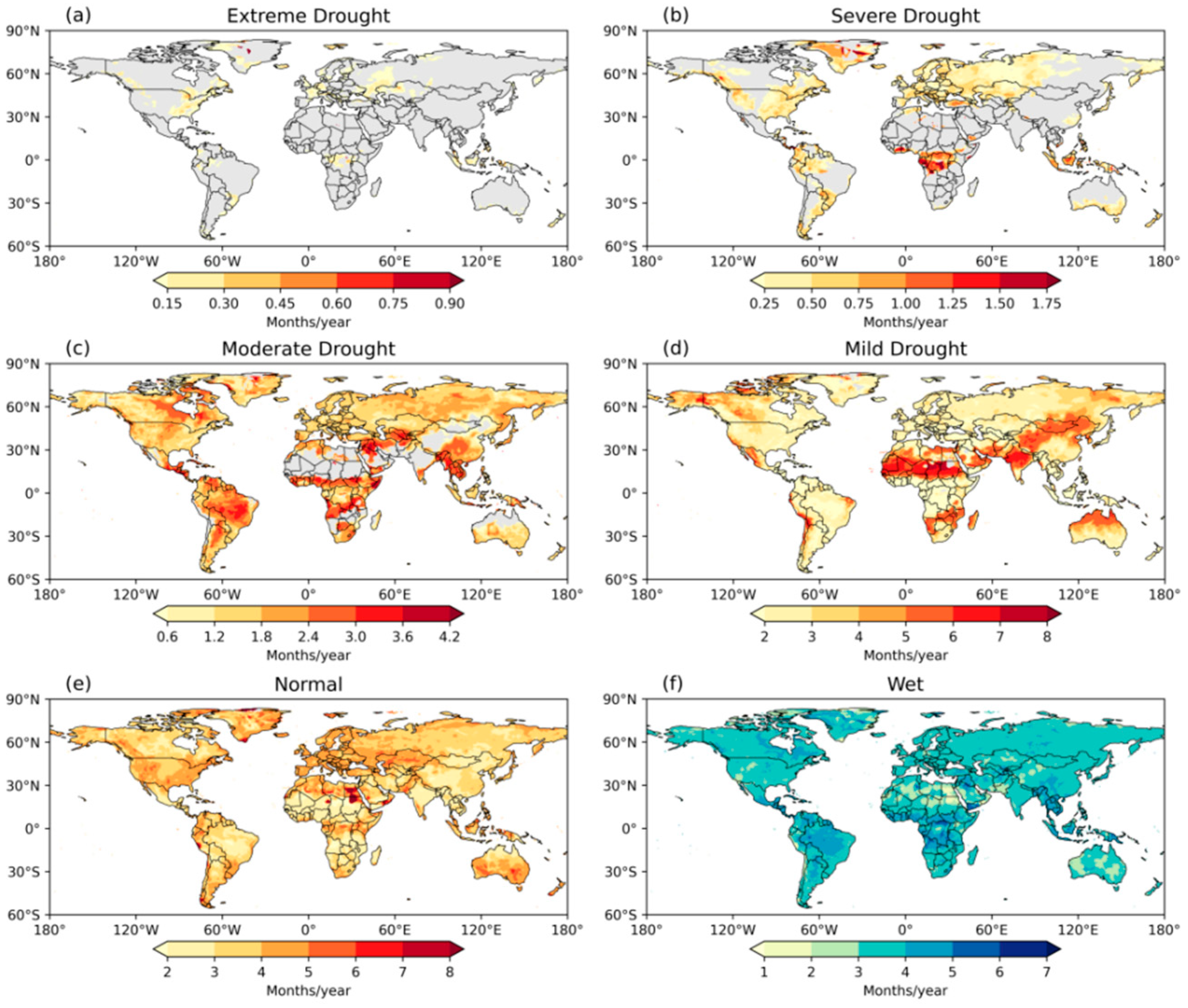
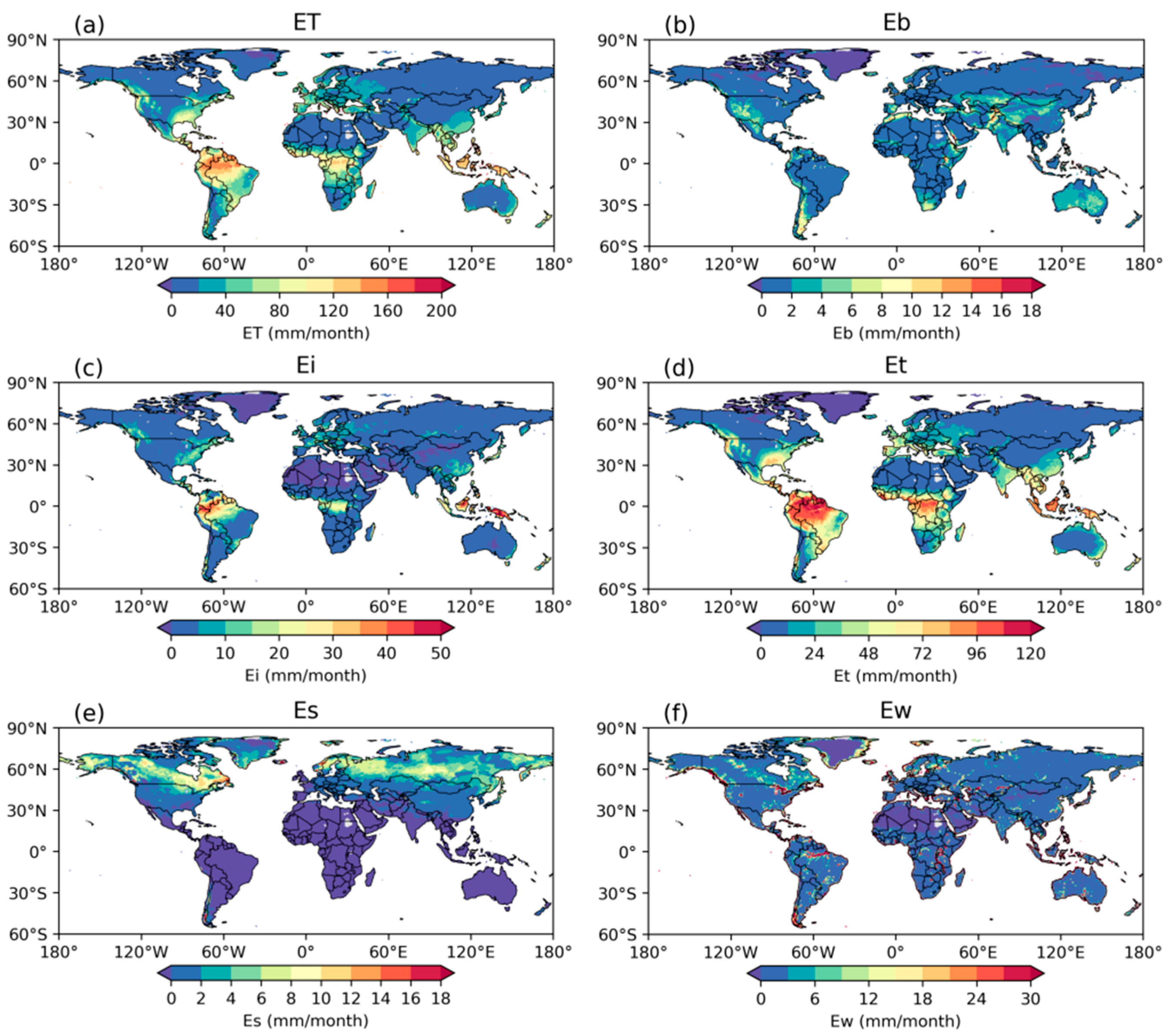
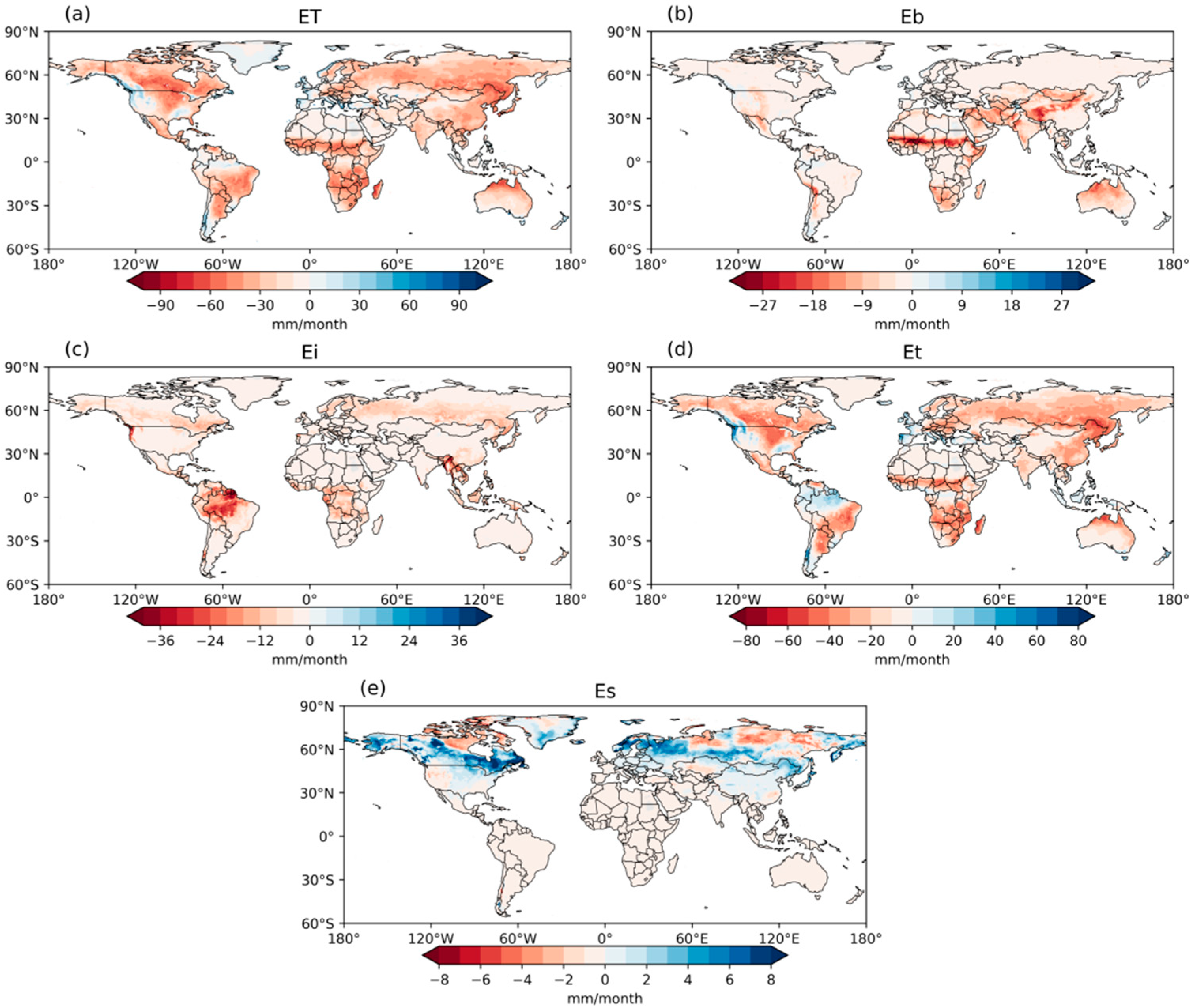

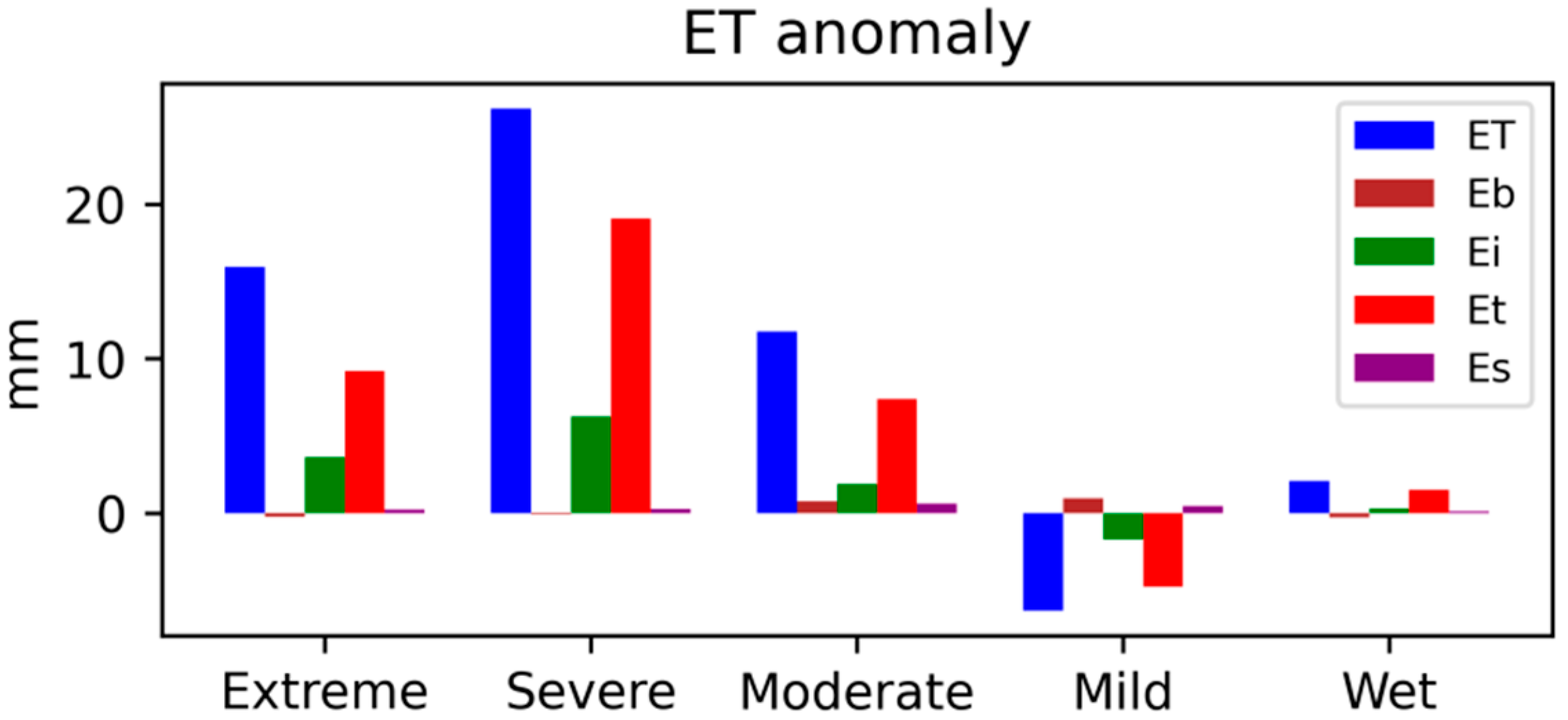
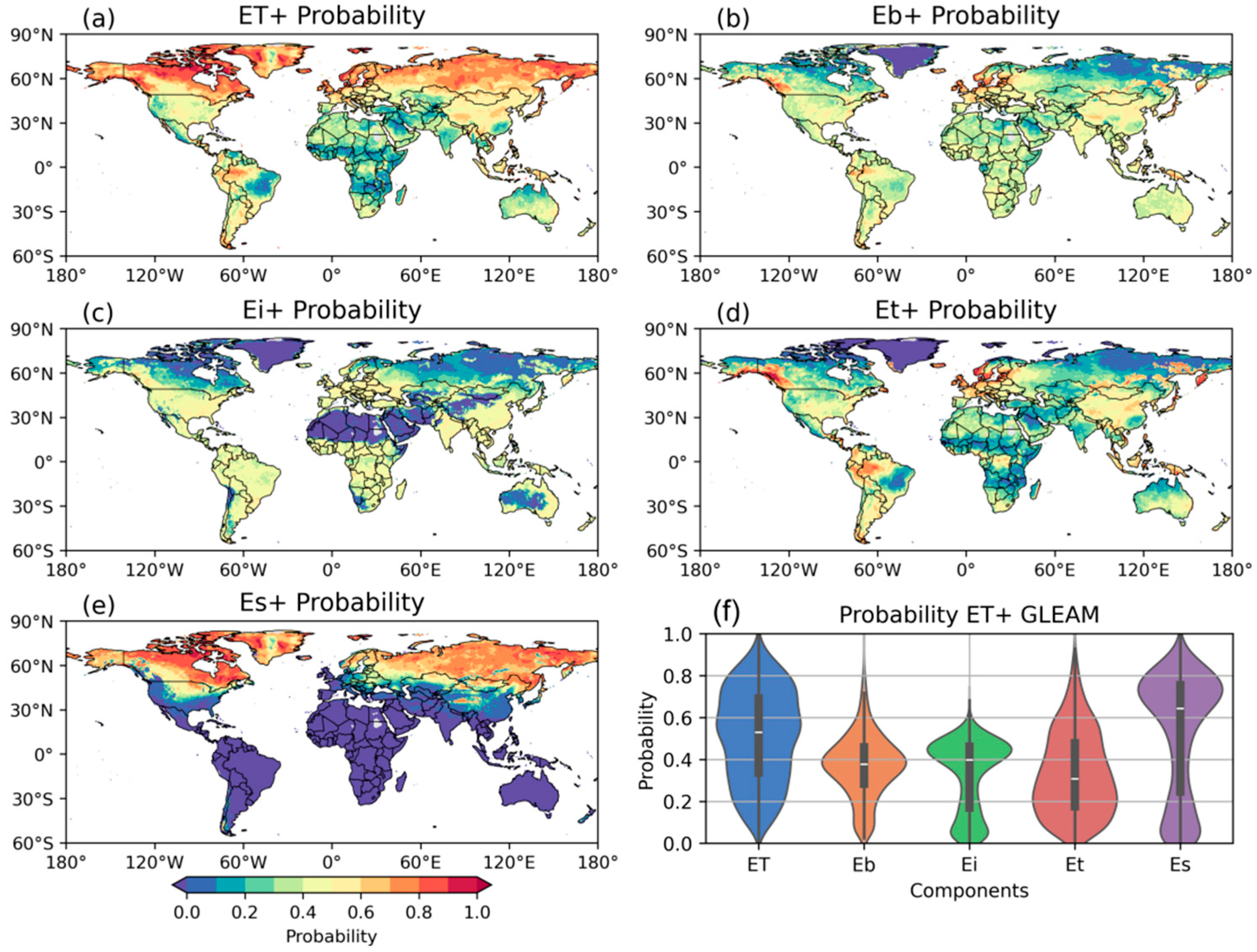
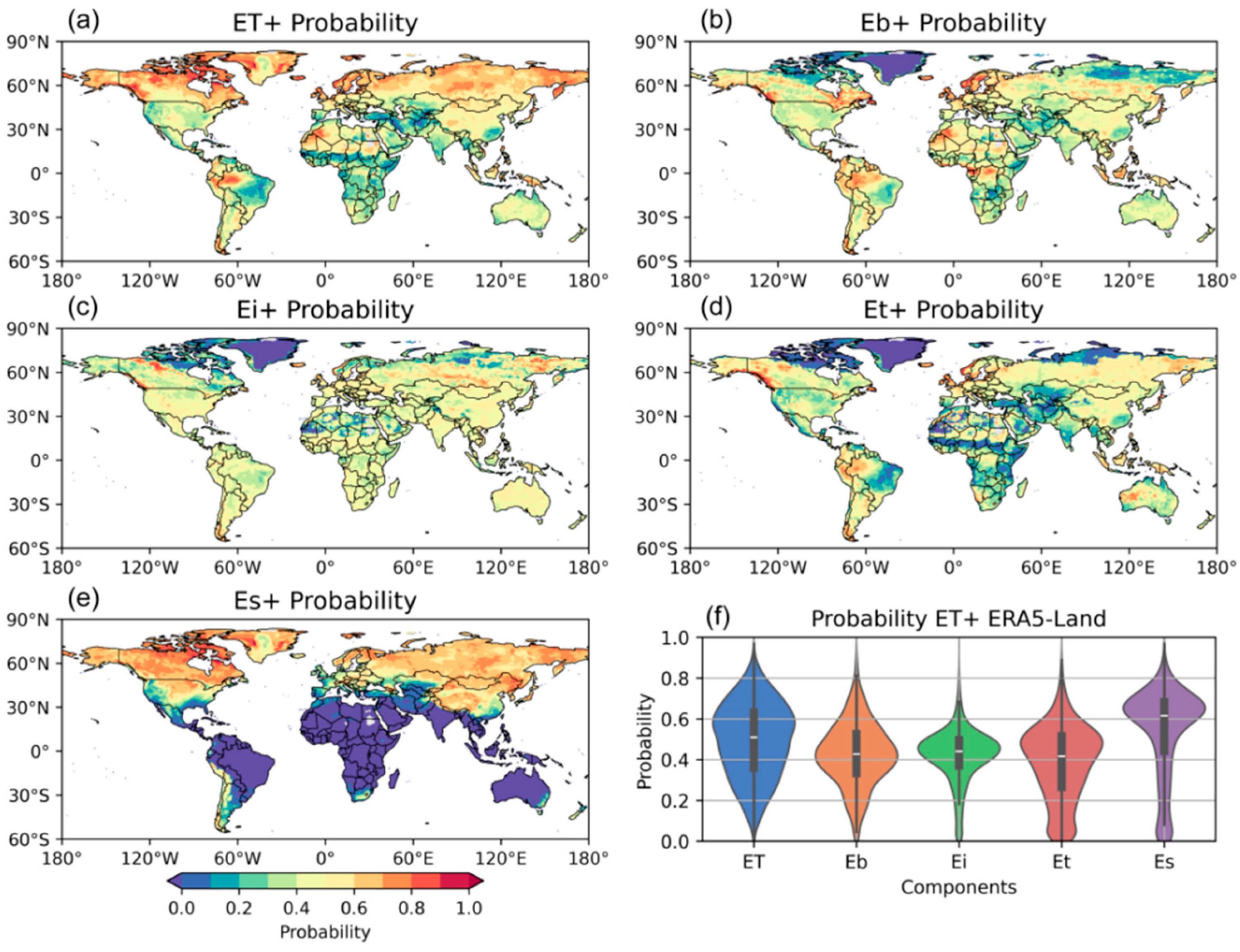
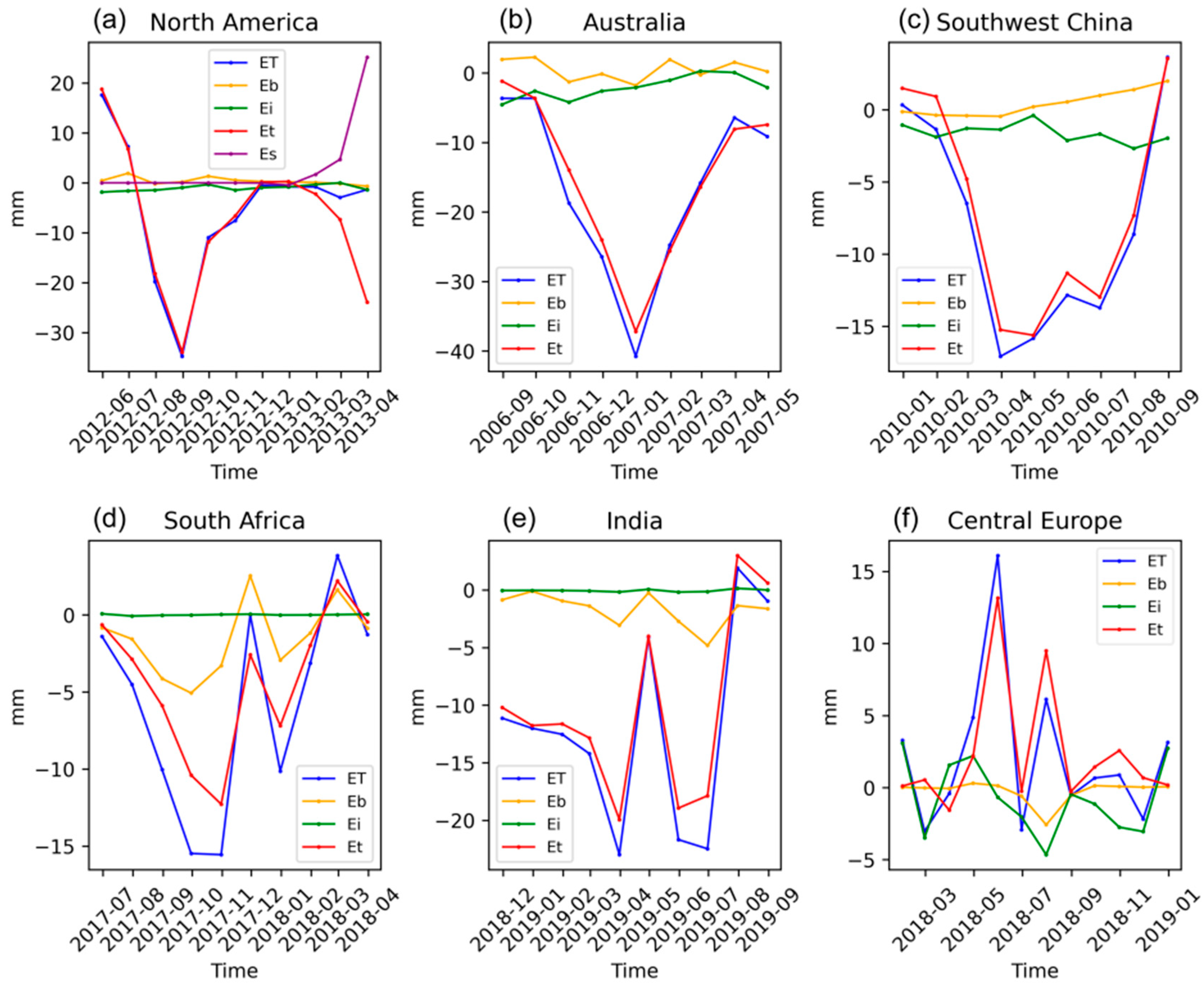
Disclaimer/Publisher’s Note: The statements, opinions and data contained in all publications are solely those of the individual author(s) and contributor(s) and not of MDPI and/or the editor(s). MDPI and/or the editor(s) disclaim responsibility for any injury to people or property resulting from any ideas, methods, instructions or products referred to in the content. |
© 2025 by the authors. Licensee MDPI, Basel, Switzerland. This article is an open access article distributed under the terms and conditions of the Creative Commons Attribution (CC BY) license (https://creativecommons.org/licenses/by/4.0/).
Share and Cite
Wang, R.; Zhu, H. Global Asymmetric Changes in Land Evapotranspiration Components During Drought: Patterns and Variability. Remote Sens. 2025, 17, 2790. https://doi.org/10.3390/rs17162790
Wang R, Zhu H. Global Asymmetric Changes in Land Evapotranspiration Components During Drought: Patterns and Variability. Remote Sensing. 2025; 17(16):2790. https://doi.org/10.3390/rs17162790
Chicago/Turabian StyleWang, Ren, and Hongyu Zhu. 2025. "Global Asymmetric Changes in Land Evapotranspiration Components During Drought: Patterns and Variability" Remote Sensing 17, no. 16: 2790. https://doi.org/10.3390/rs17162790
APA StyleWang, R., & Zhu, H. (2025). Global Asymmetric Changes in Land Evapotranspiration Components During Drought: Patterns and Variability. Remote Sensing, 17(16), 2790. https://doi.org/10.3390/rs17162790







